Monday, May 4, 2009
Sunday, May 3, 2009
Downtown Farmers Market
First of the season!
Say what you want about Iowans, but don't say that they lack appreciation for the Spring and Summer. Around this time the entire landscape seems to erupt with joyous celebration for the warmer climes. Tulips erupt out of the ground like rockets, barbeques are lit with haste and Iowans look forward to the agriculture on display at the market.

Such was the case this Saturday at the first official Downtown Des Moines Farmers Market, held in DSM's Court Avenue district. As you can see, the courthouse presided over the masses of people who came out to see the (admittedly meager) offerings of the farmers after such a cold and depressing winter.

However, come out they did, and the farmers market tried its hardest. LIve musicians played at corners and a variety of food vendors were on hand, including quite a few of my friends.
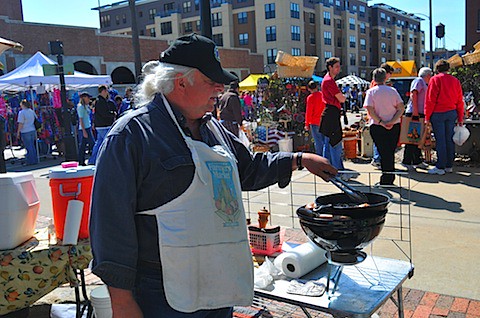
My first stop was to the Niman Ranch booth, where Larry Cleverly was handling the grill- cooking some delicious Niman sausages, bacon and chops which he fed to Jim, my FM companion, and myself. Dripping with grease and hot off the grill they were the perfect way to start a day.

From there, we drifted down to the booth of La Mie, my favorite bakery (ever) where they were selling sumptuous pastries and delectable savories, such as the baguettes pictured above. Bonus: I got to shake the hand of Joe Logsdon, the amazing baker behind the flour power of La Mie. I don't think I will wash that hand ever again; it was like talking to a demigod of the baking world.

Just down the road Lois Reichert, the wonderful woman behind Reichert's Dairy Air goat cheese dairy, was selling her cheese. Actually, business was pretty dull when I got there. She had sold out of all of her flavored chevre's, her robiola and her feta. All that remained was a culinary joy ride: a coffee infused chevre topped with a chocolate ganache. It was delish though, and we had a fun time catching up. She is looking forward to the end of the kidding season: her goats have been popping kids out gangbuster style: she recently had to deliver quintuplets! Let me relate to you a notable exchange:
Lois: So far the most interesting thing I have learned how to do is to dilate a cervix manually
Me: Wow!
Lois: It wasn't that hard- just common sense really.
I will keep that in mind the next time I see a cervix in need of dilation- I will just use my common sense.
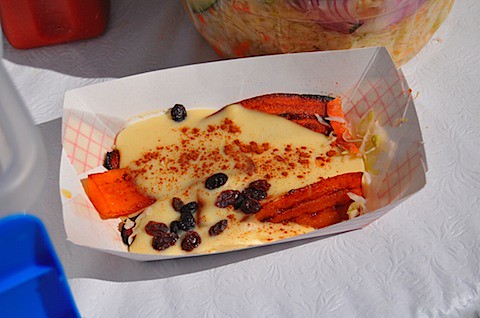
While I focused my attention mainly on my friends among the farmers, there were a variety of wonderful restaurants. including the above Salvadorean place. They had a link at least 20 people long for the duration of the market, as they churned out papusas and canele (I think thats the name): fried plantain covered with sweetened condensed milk and raisins. I didn't have one, but they looked good!
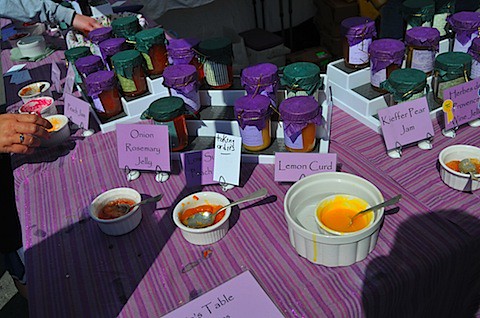
Jams were well represented- this lady had at least 20 types, if not more!
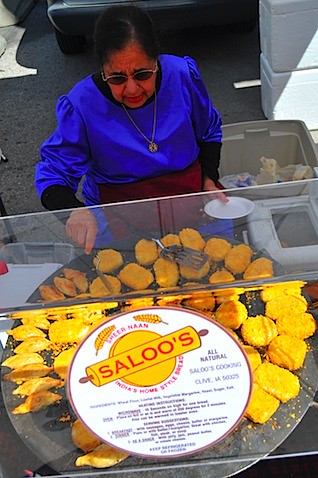
Des Moines does not lack for amazing Indian, as Saloo's showed. Jim told me that they have been an installation since the first market. Everything looked fresh fresh fresh!

Equally authentic were the pastries on display at the booth of the Strudl Haus in Altoona (www.strudlhaus.com). They had a variety of Austrian style pastries that hearkened me back to Berlin. Frequent readers will remember that I believed the Northern countries (Denmark and Germany) to have the superior pastry making style, and Strudl Haus' wares reminded me that I do favor those hearty dense concoctions, jammed with berries.
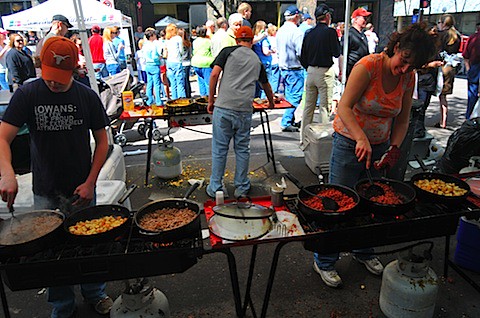
Less authentic, but no less delicious, was the assembly line of Farmboy burritoes. As you can see, proud Iowans cooked huge pans of eggs, bacon, potatoes and sausages to keep up with the insatiable breakfast burrito demands of block-long line of hungry Farmers Market patrons.
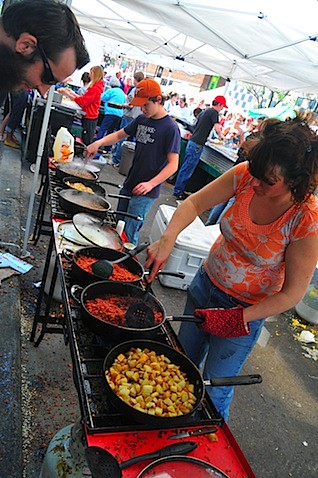
My friend Boonie, upper left, looked at the double pans of bacon, a wistful look in his eyes.
With the farmers market winding down around 12:30, Jim and I adjourned to Centro, one of my fave places in the city. George Formaro, thew owner, pioneered an 850 degree pizza oven in this upscale Italian joint. I could taste the difference in the amazing pizza margherita I had.
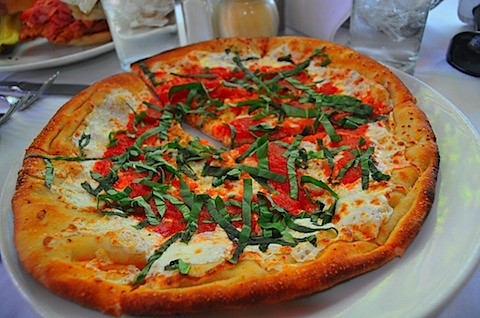
George started his career as a baker, and he grasps the fundamental importance of a great crust. The pizza was basically incredibly good bread, that he been zazzed up with some excellent fresh mozzarella, delectable tomatoes (not too much!) and a sprinkle of fresh basil. The crust was crispy, delicious and overall FLAVORFUL. All pizza makers should take note: a flavorful and crisp crust is everything! The toppings are just enhancements! Take care of the crust first, and then a delicious pizza will follow.

As you can see, the pizza was the best type of simple: good ingredients, unadorned, produced a superior pie.
Simplicity was not the name of the game for the Kill Bill sandwich. Bill Overdyke, the executive chef of Centro, had pioneered this sandwich for a, lets just say different type of gourmet. Whereas I prefer the simple elegance of the Pizza Margherita, some prefer this:
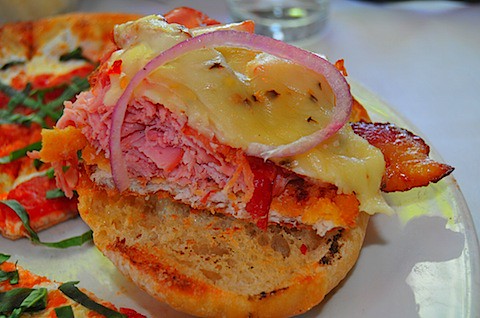
Saturday, April 25, 2009
Is it World War 1 all over again?
Although the facts are hardly in yet, he cites a report from a firm called Veratect, which maps outbreaks for clients like WHO and the CDC. From the report:
"They believed that the farms, operated by Granjas Carroll, polluted the atmosphere and local water bodies, which in turn led to the disease outbreak. "
I have a hard time believing that some of the blame for this cannot be laid at the feet of factory farm, with their well-documented scarcity of hygenic oversight.
I look forward to see what this outbreak does to cleanliness on hog farms.
Saturday, April 18, 2009
Niman Ranch
I enjoy farm visits. I love tromping through the fields, seeing where the ingredients which I use to cook everyday are grown, that kind of thing. But what I enjoy the most is meeting the farmers. I have yet to meet a farmer who hasn't embraced me immediately as their best friend, piling my car with food.
The Willis', who are the founders of Niman Ranch Pork Company, took this hospitality and friendliness to a whole other level.
I should have known this; I have heard from numerous sources that Paul Willis, the orginal founder, was "a really great guy" who, I was assured by multiple people, I would love. I unfortunately did not get to meet Paul, but I had a fortuitous meeting with his equally-generous daughter Sarah at an event in Des Moines, which culminated with one of the most pleasant farm visits I have participated in.
I should start off with some history of Niman Ranch and what it means to be their "pork company". Niman Ranch retails a variety of meats and products; all sorts of beef, lamb and pork. Their business model is based off of helping small farmers, who sell their product (which must be raised in accordance with the tenets of Niman Ranch) to Niman. Niman then transports it and retails it to stores like Whole Foods and Trader Joes.
So to say Paul Willis "founded" the Niman Ranch Pork company is a bit disingenuous. Really, as Sarah explained to me, it was more of a bet that Paul had with Bill Niman. Bill was, at the time, getting his pork from a small farmer in Northern California. At a party the two men met and (allegedly) Paul attested that his pork was better than whatever Bill was getting. Paul followed through and mailed some of the pork from his farm out to Bill, who was forced to agree: Iowa pork is the best. And thus Iowa became pork central for Niman Ranch, and eventually much of the United States.
Paul and his farming practices fit naturally into the Niman umbrella. Paul had been pioneering free-range farming for a long time before he met Bill and was, like many Iowans, a sensible individual: he didn't think it was right to add antibiotics straight into the pig's food. Free range farming, without antibiotics, is now a cornerstone of the philosophy that all 620 pork farmers in Iowa who produce for Niman must follow. And it all started with Paul.
So, needless to say, I was excited on the ride to Thornton, where the Willis' still live. Along for the ride I had my esteemed friend Jim Duncan, who instead of being a deadbeat college student avoiding work, is an actual writer. We spent the time discussing, as are wont to do, food.
After a few wrong turns we arrived at the picturesque farm where it had all started. The farm was probably much improved by what was becoming one of the finest days I have yet encountered in Iowa: sunny, clear as a bell and warm. Sarah welcomed us warmly and showed us around the farmhouse, which was once the Willis' home but has now become a dedicated set of offices.
We walked around the interior, oohing and aahing at the pictures of chefs (signed) and the map on the wall which showed, via push pin, the locations of the numerous small farmers which comprise Niman Ranch's pork producers. We talked for a long time about NR's policies, but it really can be summed like this: the pigs raised by the Willis' only have one bad day in their life. And they are working on making even that day better. Sarah ushered Jim and I out back to demonstrate with a live example.

My first question, when I saw the fields where the pigs are raised, was how the pigs didn't run away. From a distance the fields simply look like a collection of cozy aluminum sheds. When I got closer, I realized that all that was needed to keep the pigs in was one length of electric wire strung about 12 inches off the ground. Why would the pigs want to go anywhere anyway?
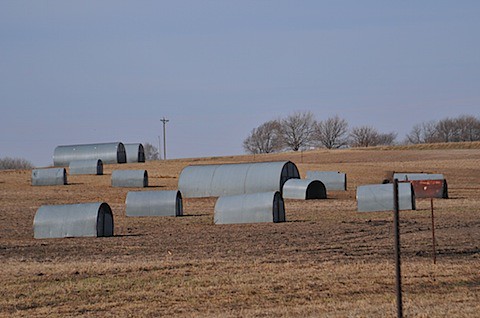
It was peaceful out on the fields. The sows laid happily in their sheds, nursing adorable litters of piglets. We walked around quietly, simply observing the pigs in their element. Piglets ran around, while the mothers would occasionally run around playing with them as well. Although I have heard of pigs as some of the more ornery animals, I realized that these pigs at least did not conform to that image.
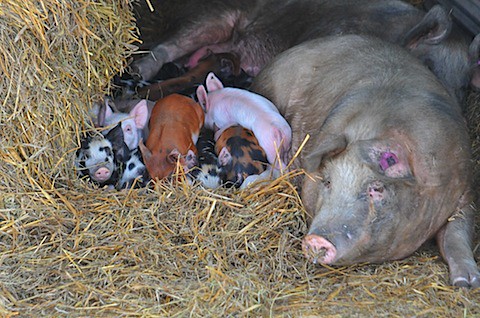
Sarah explained to me, as we quietly, reverently almost, strolled among the pigs, that their pigs are different. All piglets of a certain cohort are raised together, so that they were all of about the same age. For example, all the pigs (not the sows) in each enclosure were of an age. Pigs are social animals; this structure lets them thrive. Additionally Niman does not dock their pigs' tail nor cut their teeth. Normally this is done so as to prevent pigs from biting each others tails. It turns out that this is only necessary when the pigs are stressed: Niman Ranch pigs need no such treatment.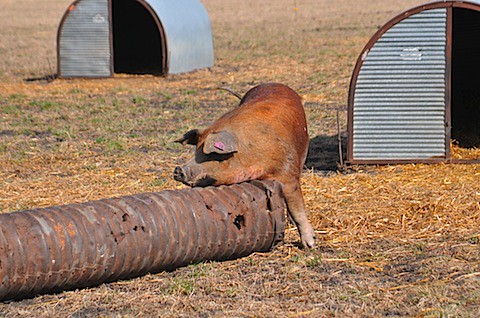
As you can see, the pigs seemed more concerned with scratching themselves in the beautiful Iowa sunshine than being aggressive. I approve.
Even the piglets roam around fearlessly; they were absolutely adorable!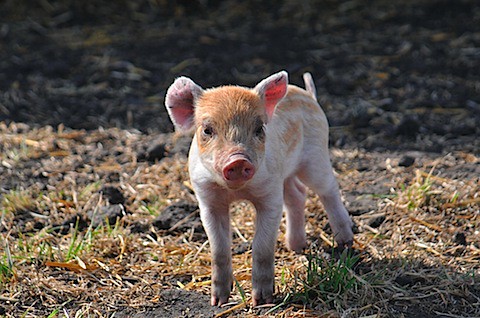
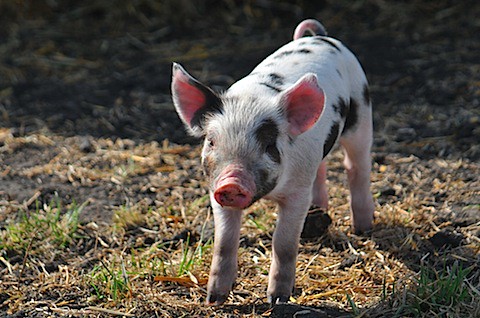
This free-range lifestyle translates into better meat: happy pigs, apparently, do make better pork. The breeds of pigs used (farmers hybrid and berkshire)are more hearty and also more fatty than the lean "other white meat" pig varieties used by factory farm producers, such as Hormel. These pigs develop meat that is full of intramuscular fat from a life full of frolicking.
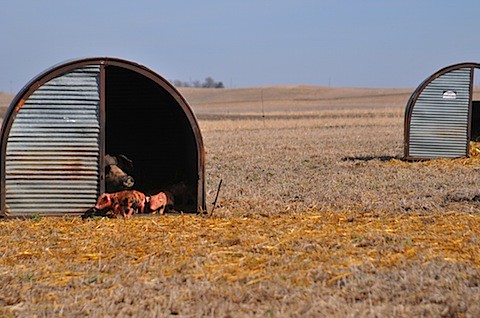
Each sow gets her own enclosure, which is filled with straw.
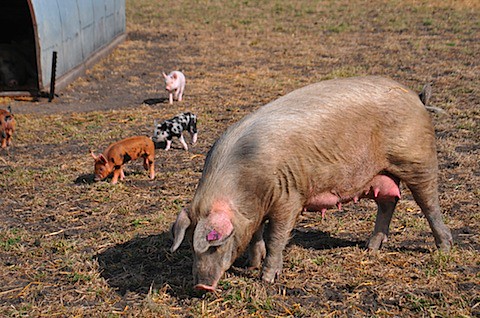
The sows felt free, after a while, to frolic with their little piglets in our presence.
At length, we were getting cold and Sarah took us over to the "dream farm", where her father Paul and mother Phyllis live currently. Paul, unfortunately, was in California, but Phyllis was generous and kind enough for any 5 people. The reason it is called the dream farm, by the way, is because it is surrounded by 140 acres of virgin prairie. The Willis' had just finished burning it, but already shoots of wildflowers were poking through. I can only imagine how beautiful it is during the summer, when Phyllis and Paul can sit on their porch, listen to the frogs in the pond and the chickens in the yard, while the fireflies dance about the flowers. Amazing, I am sure.
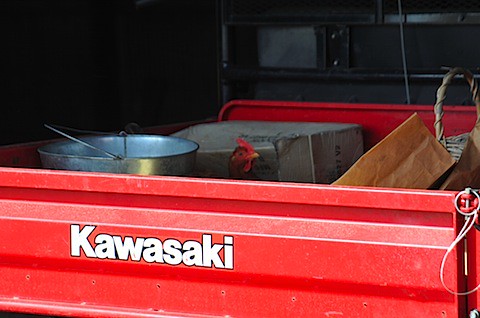
Phyllis' chickens, like their pigs, are also free-range. As you can see, they make their nests everywhere. When we went for a ride in that truck later, we first removed 2 eggs.
It really was a magical visit. I don't think I have ever met people who live their own philosophies as effortlessly at the Willis' do. I hope they, and Niman Ranch, continue to thrive.
Sunday, April 12, 2009
Free Range Trichinosis? Hardly!
However, McWilliams’ piece is misleading at best and false at worst. While he is correct in noting that there are higher incidences of salmonella, toxoplasma and trichinosis in free-range pigs, he glosses over the dangers of methicillin resistant staphylococcus aureus (MRSA) in confinement-raised pork. Additionally, he plays the “responsible animal husbandry” card, asserting that modern pork farming has given us more reliable sources of cheaper meat with more consistent flavor by “raising animals indoors, fighting their diseases with medicine and feeding them a carefully monitored diet”. He glosses over the worst aspects of factory farming, instead referring to a utopian confinement farming system that does not exist in this country.
McWilliams’ first piece of evidence that free-range pork is more dangerous is a piece from the journal Foodborne Pathogens and Disease. The article studied 600 pigs in North Carolina, Ohio and Wisconsin and found increased levels of salmonella, toxoplasma and trichina. While I could not find the article he mentions, I do not choose to dispute these findings; I will accept that free-range pigs are exposed to more vectors and therefore may have higher incidences of parasites or bacteria. However, this evidence is immaterial for two reasons. The first is that both types of pigs carry these pathogens: really, there is a 50% chance that a free-range pig has salmonella versus a 40% chance a confinement-raised pig has the same pathogen. In either case, the exposure risk to salmonella is large-if the person hasn’t used appropriate food handling procedures! For both types, the pork must be cooked and cross-contamination limited- as all food should be. Secondly, the three pathogens he mentions are not particularly hazardous. Sure, it is unpleasant to get salmonella (which causes some decidedly unpleasant symptoms for 4-7 days) or trichinosis (which causes you to feel decidedly anti-social for 4-6 months). However, in both of these cases proper food handling procedures reduce the risk to negligible levels. In the case of trichinosis, the danger is far more real if you are handling game. The Center for Disease control reports that from 1997-2001, there were only 12 cases per year of trichinosis, and that “it was less commonly associated with pork products and more often associated with eating raw or undercooked game meats” (1). And as for toxoplasma? You are more likely to get that by cleaning your cats litter box and failing to wash your hands than from a pork chop. Therefore, this claim is dismissible due to the prevalence of these pathogens in both types of pork, as well as the relative harmlessness of the threats they present.
However, what McWilliams does not discuss is the prevalence of MRSA in confinement-farmed pigs. Nicholas Kristof, in two superb pieces in the Times entitled “Pathogens in Our Pork” and “Our Pigs, Our Food, Our Health” exposes the danger and prevalence of MRSA in confinement-farmed pork. The reason MRSA is so scary is that- as its name suggests- it is resistant to the primary types of antibiotics we use in our hospitals. This resistance is largely due to irresponsible use of antibiotics in pig feed (which I will discuss later). In the US, 18,000 people per year are killed by MRSA. Now, they were not infected through pork consumption (and indeed, the link between eating pork and getting MRSA has not been proven), but the prevalence of a unique strain of MRSA (called ST398) that appears solely on confinement pork farms is growing. In addition, confinement-raised pork is more likely to have other bacteria, like salmonella, that are antibiotic resistant.
In his article, Kristof relates the anecdote of townspeople in Camden, Indiana contracting “pimples from hell”, which turned into lesions “as big as saucers”. Tom Anderson, a doctor in the community, sent cultures off to the lab that identified the culprit as MRSA. Before Kristof could interview the doctor in person, Anderson died of a heart attack-possibly caused by MRSA. The prevalence of this ST398 is growing. A University of Iowa epidemiologist found 45% of farmers tested (and 49% of hogs) carried this strain of MRSA.
So if free-range pork has more salmonella, it must have more MRSA, right? Wrong. In an article entitled “Antimicrobial Susceptibility of Foodborne Pathogens in Organic or Natural Productions Systems”, the authors examine the antibiotic resistance of multiple types of pathogens in conventional versus organic or natural production systems. Now, free-range, while not necessarily organic, oftentimes is, and free-range pork rarely receives antibiotics du jour, as conventional pork does. Therefore, I will conclude that the results are, for the most part, applicable. In the study, the authors find a statistically significant difference between conventional and free-range pork: prevalence of antibiotic resistant bacteria (including E. Coli, salmonella and campylobacter) was much lower in free-range pork- oftentimes stunningly so. The author concludes that, while “the associations were not always observed, they were rarely reversed”.
This leads into my final rebuttal against McWilliams’ article: that raising animals indoors, fighting their diseases with medicine and feeding them a carefully monitored diet is a good thing, because it makes pork more reliably available, safer to eat and consistently flavored. I have 2 main arguments against this. Firstly, those methods are rarely followed by big “factory farm” producers, and secondly, that the “benefits” of such farming are actually positive. He preempts my argument by stating that “the critique of conventional animal farming is right on the mark”; however, he is being disingenuous through the rest of the article when he fights against free-range pork farmers and fails to mention the atrocities of factory farms.
As the ever-formidable Kristof notes, 70% of all antibiotics go to animal feed for healthy livestock- causing this explosion in resistant strains of bacteria. Legislation to block the non-therapeutic use of antibiotics in feed has been blocked by agribusiness interests. Now, as I mentioned, free-range pork could still technically add antibiotics to feed. However, free-range pork is often organic, which means they cannot. In addition, even non-organic farmers, such as Iowa Farm Families, will not sell pork that has been given antibiotics under their label; pigs that are treated are noted and sold under a different brand. Generally, free-range farmers are more responsible than their more monopolistic brethren, and forgo the use of antibiotics. Therefore, I feel confident linking the superior safety of organic foods to free-range pork as well.
Finally, the benefits of this system (more reliable supply of consistently flavored and cheap pork) are not really benefits. You know what else is consistent and cheap? McDonalds. This is a normative statement, but I like my pork to be meaty, with a unique flavor, and even a little unusual. It’s true! While the benefits of more unique heirloom and free-range pork varieties, while existent, are beyond the scope of this article, I would direct you to an excellent Times article on the same topic.
In conclusion, McWilliams’ article misses the point. He over exaggerates the dangers of diseases that are easily prevented and treated, and ignores the dangers of antibiotic resistant strains of bacteria such as MRSA, E. Coli and salmonella which are not. Additionally, he cites the “more is better” argument: that we shouldn’t complain that we can now get more pork more cheaply. I think we need to return to a time where we didn’t spend so indiscriminately, and took quality over quantity.
Tuesday, April 7, 2009
Spring Break: Chez Panisse
My trip to Chez Panisse

The sun was in my eyes!
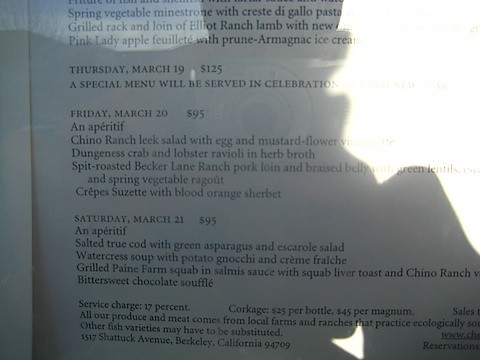
The menu
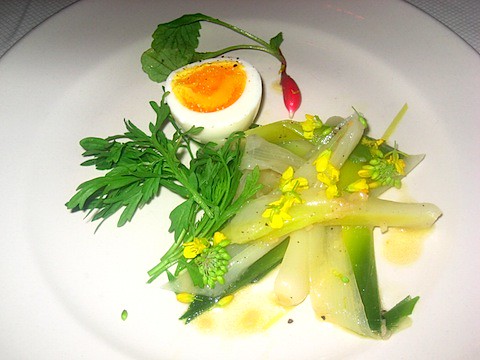
Chino ranch leek salad with egg and mustard flower vinegarette
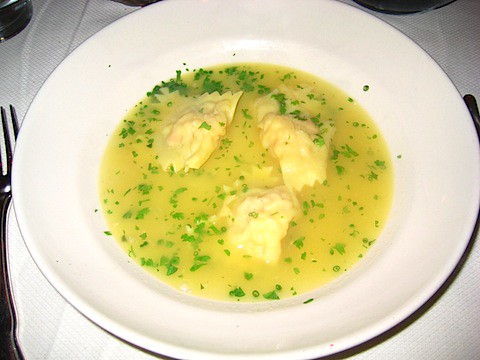
Dungeness crab and lobster ravioli in herb broth.
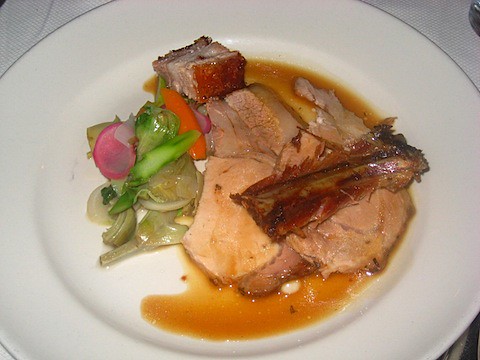
Spit roasted Becker Lane ranch pork loin and braised belly.

Crepe suzette
Sunday, April 5, 2009
If you aren't planning on attending Cochon 555, why not?
On April 19th, 5 local chefs from Des Moines will be provided with 5 heritage pigs (one each) and then asked to prepare the whole pig, every part, for a crowd of 200-plus hungry Iowans. 5 family-owned winemakers produce wines for this porcine feast. All the proceeds for the Des Moines event go to support the Leukemia and Lymphoma Society. This sounds simple, and it is, but I believe it can have a profound effect in changing the attendees into consumers who engage with their food purveyors to find out the full story behind their food.
Competing in Cochon, Des Moines version, we have a star-studded line up of some of my favorite chefs: Andrew Meek (Sage), Matt Steigerwald (Lincoln Café), Jamie Monaghan (The Embassy Club), Tag Grandgeorge (Le Jardin) and Bill Overdyke (Centro). All of these noble competitors are top notch and will churn out a feast that will shock and awe those who are unfamiliar with their work.
I have always considered myself to be a fairly enlightened gourmet. I can tell you the difference between free range and organic chicken, I support family farms and I say things like, “I deplore the commoditization of food”. But my conversation with Brady made me realize how much I could learn, and how much his event, with its emphasis of education and outreach, can teach our society, not about what we eat, but where it comes from and how it is raised- the “story” behind our food, if you will.
Cochon is more than just an excuse to (pardon me; I can’t resist) pig out on some good food. As Brady Lowe explained to me on the phone the real goal of the event is to educate the attendees (whether they be experienced gourmets or someone who just loves food) about the importance of engaging with the farmer behind that pork tenderloin, steak or chicken breast.
All the pigs for the event are “heritage” varieties from small, family owned farms- a stark contrast to the pork in most grocery stores; shrink wrapped and bearing a label from “Hormel” or some other monolithic producer of commoditized, flavorless meat. Heritage pigs are lesser-known varieties, which are not as widely raised, generally because they do not bulk up as quickly, which reduces the meat yield relative to investment. However, oftentimes they are much more delicious, as these varieties will be. Mr Lowe hopes that the exposure to the succulently tender, flavorful and healthy pork that comes from these rapidly disappearing varieties of hog will show the audience the importance of engaging with food and finding out its story: where it came from, how it lived and how it got to the plate. In the end, he hopes to expand this dialogue between consumers and producers.
This vision comes is particularly evident in the chef selection process. Practicing what the he preaches, Mr Lowe explained that the three main criteria are that the chefs have an “in house pig program”, that they source food from local farms (“For protein and produce”) and that the chefs are ambassadors to the community. In house pig programs, if you do not know, are the procedures and equipment that allow chefs to take an entire pig and break it down into manageable pieces, as well as create some of the finest products of the butchers art- pates and other charcuterie. Generally, the presence of such a program is intimately linked with the other facets for which Mr Lowe looks.
Honestly, I cannot recommend this event enough. Is there anything not to love about it? Great food, a good cause and wine: what more encouragement do you need to go to their site (www.amusecochon.com) and buy a ticket as soon as you read this?
Friday, April 3, 2009
Applecart Orchards: Vinton, Iowa
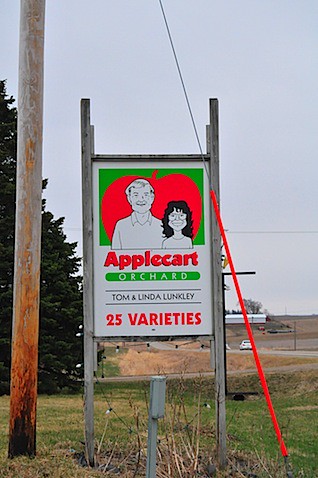
Quick: how many different varieties of apples can you name in 10 seconds? I'll try as well.
Golden Delcious
Red Delicious
Gala
Braeburn
Fuji
Pink Lady
And...stop. How many did I get, 6? And I know my apples. Over at Applecart Orchards, Allen Isreal grows over 35 varieties of apples-from standards like red delicious and gala's to more esoteric varieties, such as arkansas black and blushing goldens. That isn't all his 35 acres contains though- he also manages to grow 4 varieties of peaches and 7 varieties of pears (of those, he has 5 different varieties of asian pears). Even the winter is no barrier to biological diversity over at Applecart. In his 2 greenhouses he grows 7 or 8 different varieties of lettuce, esoteric vegetables (kohlrabi, bak choi) and more tomatoes than I could even imagine. Allen didn't brag about the orchard of eden he has created on his small farm in Vinton, just west of cedar rapids, although as I strolled around the orchard, I could feel his pride in the variety by which he was surrounded.
I should back up and mention the mechanism by which I met Allen: at a winter farmers market Iowa City. When I walked by his orchard's stand, I was dazzled by the array of apples. As I talked to him, I realized that he was a man who knew, not just the names of his apples, but the flavors as well. When I asked him about what type of apple to get, he peppered me with questions like "Do you like sweet or tart apples?" and "How do you feel about _______" where the blank would, invariably, be an off the road variety which I barely knew. As I left, I was sure to snag his card, confident that the hour and a half drive to Vinton would be worth it, even if he didn't have any more than the 6 or 7 varieties of apples he had with him that day.
Anyway, when I arrived at the farm last Thursday I was not disappointed. He took me briefly through the store, which also houses an apple sorter and a cider press, in the back. In the storage room he asked me what type of apple I would like, red delicious or blushing golden, and I grabbed the latter. And thus, chomping happily on the fruit (I later found out it had been in storage since october-some apples are still good up to a year later with careful storage) we walked into the greenhouse, which contained the aforementioned sprouts of various lettuces, tomatoes, herb and vegetables.
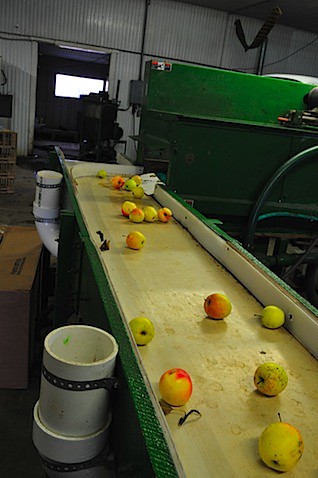
In the warm, humid air of the greenhouse Allen explained the variety of lettuces he was growing, along with well informed editorials about their flavor. I was amazed he could even remember the names of all the plants, let alone their culinary qualities. He showed me a few new varieties he was trying; mostly exotics like kohlrabi, red bak choi and sweet basil (also called thai basil). Multiple times, he invited me to grab a little seedling and bite the top of it off to taste a particularly unique flavor. it was a grand old time.

Above: Tons of lettuce! Or at least tons of lettuce sprouts. Note the variety.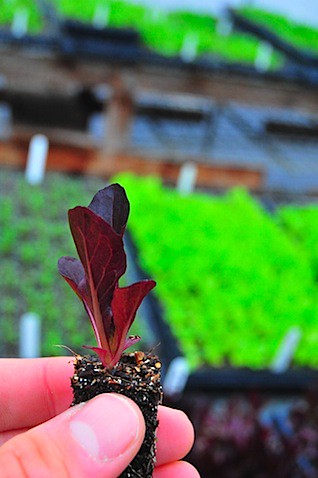
Above: A tender shoot of red romaine lettuce, just before I popped it into my mouth. Nom nom nom!
As we exited the greenhouse and walked through the rows of gnarled apple trees, he talked about the pruning process; something about which I now very little. Allen is a very careful pruner, removing the older branches so as to allow the tree as much sunlight as possible, which produces better fruit. This careful pruning also pays off: the trees last longer. A tree, he explained, is only as old as its wood. By pruning carefully, so that the branches are quite young (3 or 4 years old, on average) he extended the lifespan of his trees to about 25. He doesn't think much of this. However, I happen to remember that Hinegardner's Orchards expects its trees to last 15 years at the maximum.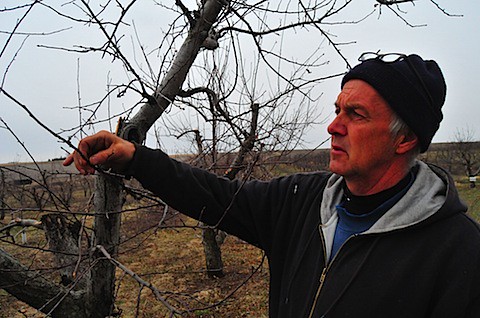
Above: Allen Isreal explains the dynamics of pruning and apple production. He is a wonderful teacher; full of interesting facts, he understatedly imparted knowledge to me during the entire tour.
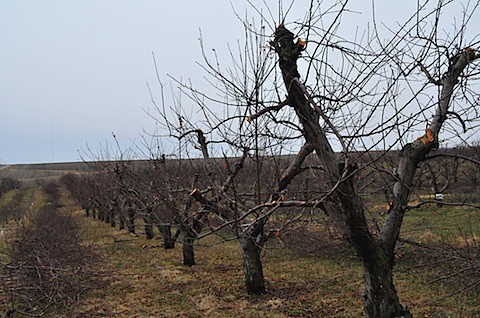
Above: a row of pruned apple trees. They look sad now, but they will be happy come summer, when the Sun's warming rays reach all the leaves.

Above: an un-pruned apple tree.
As we walked slowly towards the end of the orchard, we passed a pet project of his, 3 rows of asparagus. Strolling back, he talked about the health of his trees in relationship to this year's winter. It was particularly bad, he said, and had reached temperatures of around 35 below zero in the orchard. While his apple trees were mostly fine, none of his peaches (which are only good to -25 degrees) would be producing fruit that year- if it gets to cold the tree spends its energy repairing, not producing.
On the other side of the greenhouses he showed me another work in progress: the pears. He has 5 varieties of asian pears, with names like Golden Olympic (that type I remember; he said it tasted lightly of caramel). In addition, he has 2 varieties of normal pears.
I left, slightly disappointed I had not discovered this array of fruitly pleasure earlier. I would have gorged myself on tomatoes, lettuce, pears, apples and peaches, as well as loaded my car full to bursting. As it is, he can expect to see me at his booth, come summer.
Wednesday, March 25, 2009
San Francisco Trip-Spring Break 2009
During the middle weekend of my two week spring break, my Dad and I took a culinary road trip up to the Bay Area, where we dined at Chez Panisse. However, that was not the best meal we had; not by a lpong shot. Rather, my Dad's friend JB (below) whipped the best meal of the trip up.

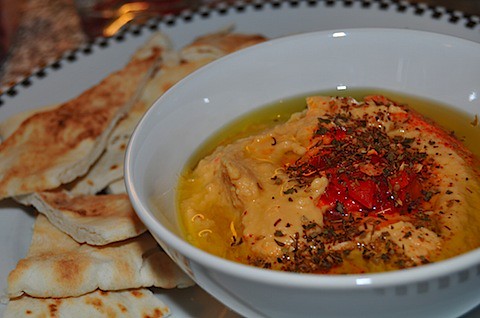
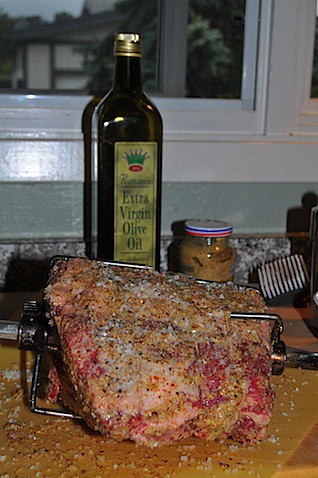
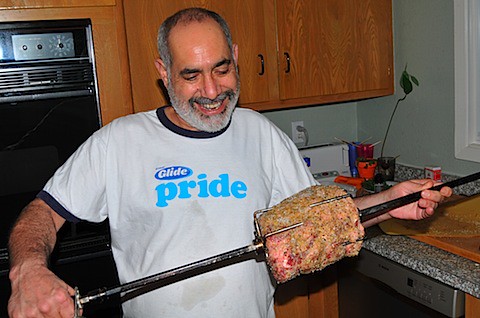

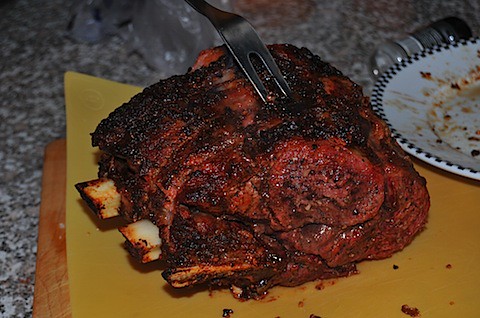


The meal just knocked me out of the park; honestly. It had everything one wants in a meal. Great food, great old friends.
Tuesday, March 17, 2009
Spring Break 2009: Sushi Gen, Los Angeles
During spring break, my friend Chris and I decided to get some nice sushi. We normally head over to Studio City when a sushi craving hits, to a place called Midori. They offer a really affordable all you can eat that has some delicious sushi and really fun rolls.
I will admit it- I love a good roll. Sushi Gen offers no such things. Here, you will find only the most traditional edo style sushi, as well as other japanese dishes which we did not try. I do not remember the names of everything, but I can describe the taste of all.
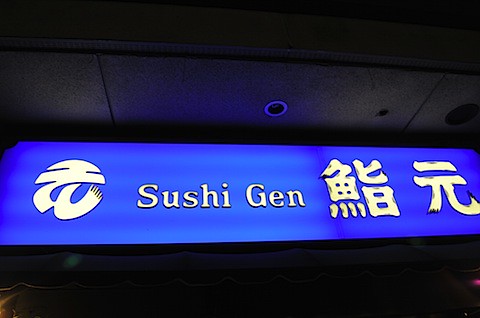



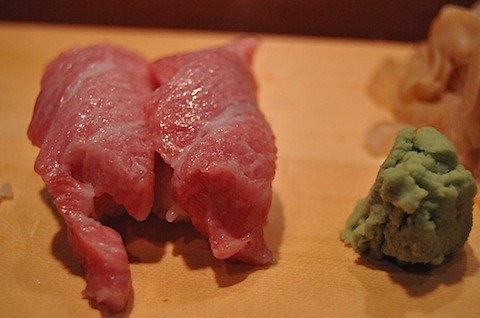
I was glad I tried this, but not overwhelmed. It had good flavor, but I cannot say I loved the texture- it was a little odd.


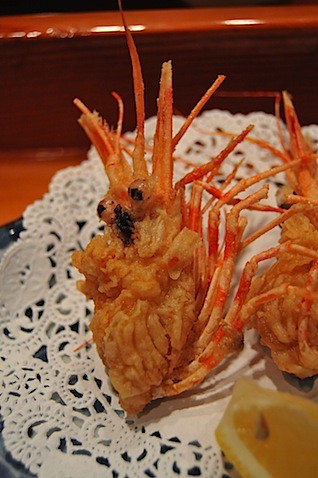
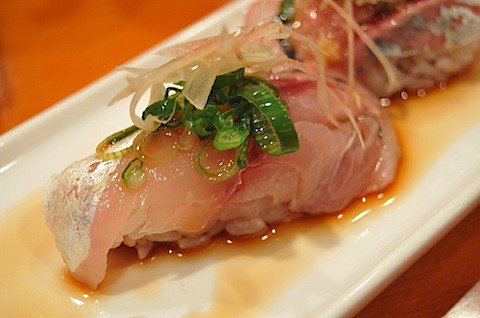
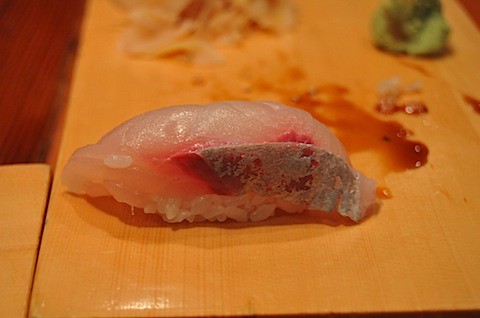

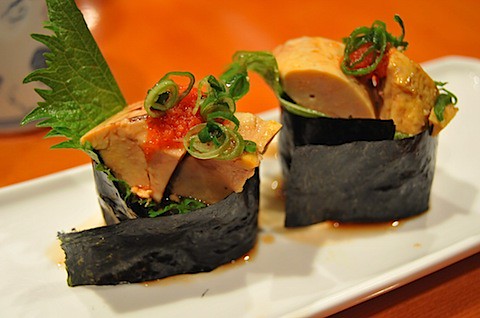
Overall, I really liked Gen. My friend and I disagree, but in mu opinion I will stick to Midori, my all you can eat place. I didn't feel like this was that much better. Or maybe I just can't taste the difference.